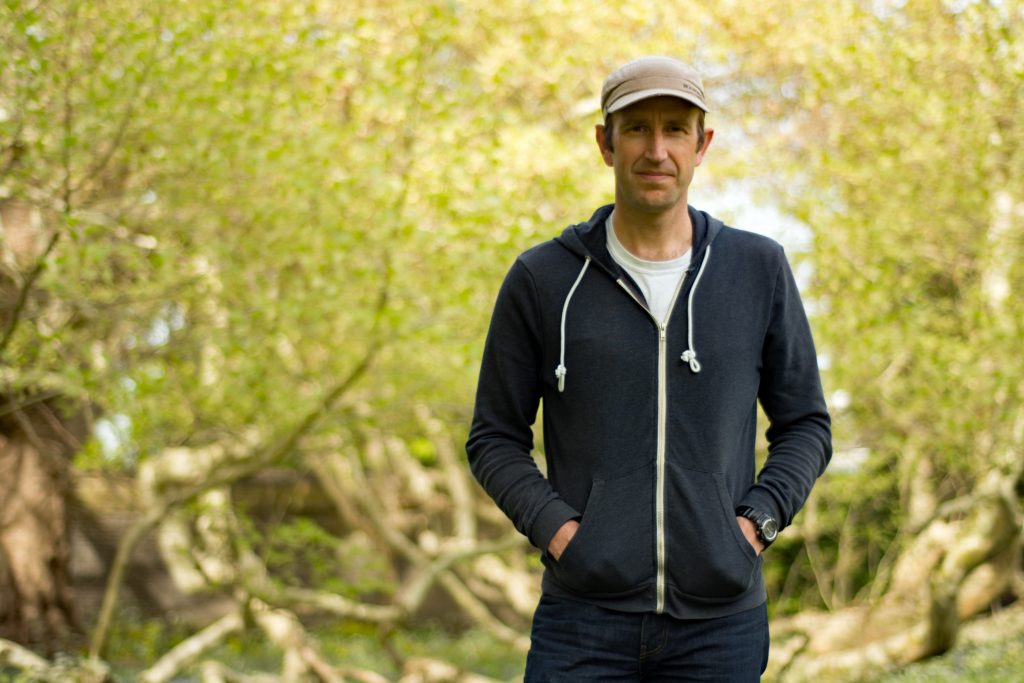 Back in the light: Robert Macfarlane in the Fellows’ Garden at Emmanuel College, Cambridge, in front of its celebrated Oriental plane, planted some time in the 1800s. Picture: MICHAEL KERR
Back in the light: Robert Macfarlane in the Fellows’ Garden at Emmanuel College, Cambridge, in front of its celebrated Oriental plane, planted some time in the 1800s. Picture: MICHAEL KERR
In his latest book, ‘Underland: A Deep Time Journey’, Robert Macfarlane travels into the world beneath our feet and what we’ve made of it — physically, with mines and tombs, and metaphorically, with myths and legends. It takes him from Bronze Age funeral chambers in Somerset, via the catacombs of Paris, to a nuclear bunker in Finland. It’s a book that expands our notions of what constitutes landscape. It’s one full of wonders — in Kulusuk, Greenland, he celebrates ‘the wildest land I have ever seen’ — but also of warnings of the harm we are doing in this overheated age of the Anthropocene. A week before publication, Macfarlane talked to DESKBOUND TRAVELLER about ‘the hardest book I’ve ever written’
Let’s start at the beginning with this glorious Stanley Donwood cover. There’s a woodland tunnel leading towards the sun, darkness into light. But that wouldn’t be a wholly accurate reading, would it? Could you explain why you see the cover as a perfect representation of what you call the “deep time journey” you make in the book?
I love the cover. It kept me writing through the most difficult times — the thought of it, the image of it. It’s called “Nether”. He painted it in 2013, and nether means under, below. In one sense it’s a holloway, a sunken lane, leading the eye on and in. What is at the end of it looks like this incandescent glow. But when I spoke to Stanley about it he said, “No — that’s in fact a nuclear explosion. That solar glow is the last thing you will ever see as the blast wave rushes towards you.”
In that sense [the cover] brings together much of the surprise of this book as I experienced it while writing. The underland summons us into it, draws us in and down, but also then pulls us into realms of extraordinary vision and extraordinary danger. It’s a place where intensities of darkness and light have existed. It’s a place where we’ve dreamed some of our most powerful dreams and it’s a place where we’ve placed some of our most terrible matter.
But this is a book about wonder as well as fear, and hope as well as loss. As well as being arresting, [the image] seemed to catch at the heart of the book’s sort-of double vision, where darkness and light are mingled together.
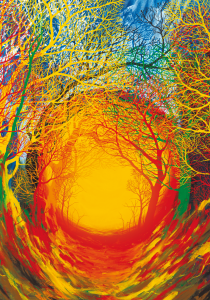
“Nether”, by Stanley Donwood
Could you summarise what the book’s about, where it takes you?
The first book I wrote was Mountains of the Mind, about what draws people to high places at risk of their lives; 15 years later here I am finding out what’s drawn us as a species into the darkness beneath our feet. It’s a journey into what lies beneath, and it’s also a journey into the more-than-human time of our extraordinary, vulnerable, ancient planet. Because what lies beneath our feet is the deep past, but also the deep future. In myth and in science the underland is where we’ve gone to find out what happened a long time ago, but also to try to prophesy our own futures. The clearest example of that is that glaciologists drill down into this extraordinary ancient archive of climate that ice holds, or that stalactites hold or that seabed sediment holds, and then read this archive partly in order to foretell climate futures.
That to me is a version of what the sibyl at Cumae is doing in Greek myth. The sibyl sat astride a chasm in the earth from which extraordinary hallucinatory mist was issuing in the Greek account of prophecy, and would foretell the future from that which the underland held. I’m fascinated with how we have imagined the underland, and how we have behaved towards it over tens of thousands of years gone and how we will behave towards it in the years to come.
Readers of your previous books will know you as someone who relishes fresh air and open space. Was it hard for you to spend so much time in deep, dark, tight places?
One of the many paradoxes, I now know, of the underland is that its confinements can be visionary, and that darkness can be a medium for forms of sight and forms of knowledge that are not available elsewhere. Dark-matter scientists have to study the birth of the universe a kilometre below the surface because that’s the quietest place in the universe; that’s where they can hear and see ghost particles and dark matter moving.
But you’re right: it can also be claustrophobic and restricting and blinding. Before I began the book I went to a friend of mine who’s a really good caver and said, “Take me underground. Let’s spend a day in a cave system that will frighten me. I want to know if I can be below ground.” He did.
We abseiled into Giant’s Hole in the Peak District, all water-carved limestone, chamber and rift. There’s a feature called the Crab Walk, which is where this rippling rift, almost shaped like a curtain, disappears into the ground. It’s only wide enough for hips to be turned sideways — and it reaches a point called the Vice, which as you can imagine is not an expansive place. John got stuck in the Vice, but I was loving it, absolutely loving it down there, so I went on with Robin, his son — there were three of us. And we just went on and on, deeper and deeper into the earth, and I was thrilled. I didn’t feel claustrophobic at all — but coming back to the light felt like being born again. Even a sheep seemed amazing.
You do things with this book you haven’t done before…
It’s the hardest book I’ve ever written. It’s taken me the longest [he signed the contract in 2006]. It may be the last. [He doesn’t mean it.]
I didn’t just have to learn to see in the dark; I had to learn to write about darkness, both the darkness of human actions and the darkness of matter. My natural inclination is to celebrate and towards joy. There is, I hope, a lot of joy in this book, but there are also chapters about atrocities and reprisal killings, about nuclear waste, about trauma, how landscapes hold memories of trauma. But it feels like the time that I’m writing into, really. It was unplanned but seems not coincidental that the book is surfacing at the end of a week, a fortnight, when we have been thinking effectively about deep-time and inter-generational justice.
Yes, Extinction Rebellion demos; David Attenborough getting a prime-time slot for Climate Change: The Facts; Greta Thunberg showing astonishing assurance for a 16-year-old…
Astonishing assurance. My daughter’s on the school climate strikes. These are all movements which are framed by three things: deep-time awareness, of the legacies that we’re leaving as a species now; by the accelerations of the Anthropocene, the ways in which planetary time is speeding up — permafrost is melting, things are surfacing; and inter-generational justice: [people are] thinking, “What are we leaving, not to our children, or perhaps even our children’s children, but to generations, billions as yet unborn?”
I didn’t know that that would be the moment of politics when I began work on this. But I’m glad. I’m glad to have written about these things.
And I loved writing about people and structures and cities. I mean, I love writing about ice, as you may have been able to tell… One of the [experiences] I will never forget is a calving [where ice breaks from or is shed by a glacier or berg]. We’re standing quietly and then this monstrous calving event occurs. I spent so long trying to work out how to write about it.
It was partly this catastrophe of civilisation as well, because that calving face is the front line; that’s going to wash the cities away. That’s what came out of it: Oh, there’s a train, and the train’s pulling a cathedral, and the cathedral’s pulling a city, and the city’s pulling a culture. And then this thing that was made by deep time, this ancient blue-black ice, comes up like a monster. And that’s what’s happening: the monsters are waking up.
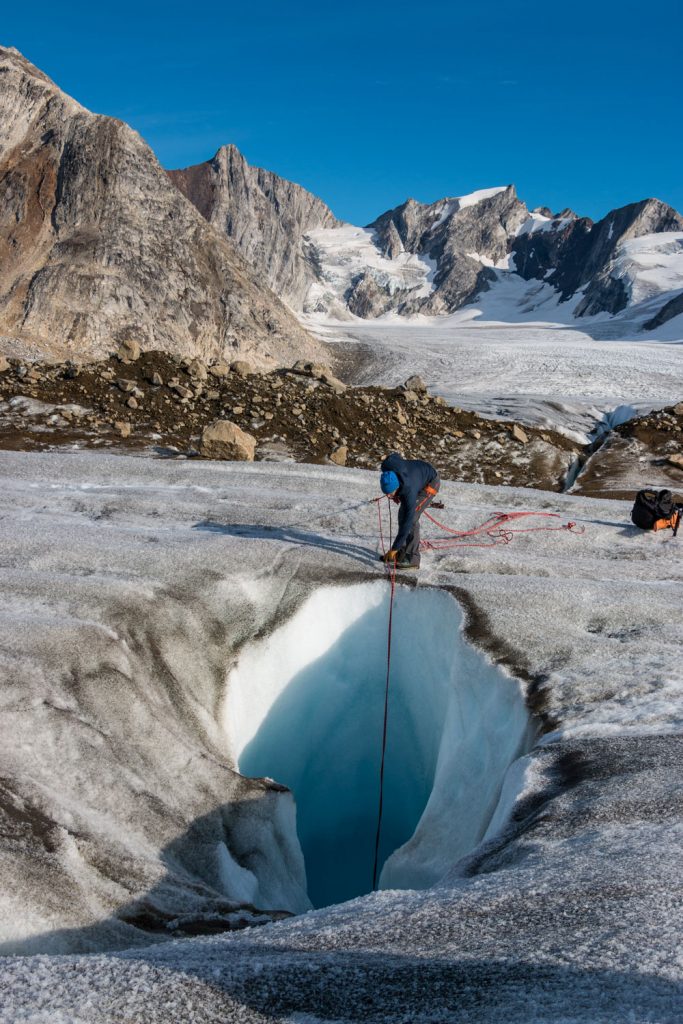
On the edge of a moulin — where meltwater gathers on a downward slope and begins to bore into a glacier — on the Knud Rasmussen glacier in Greenland. Macfarlane says in the book: “It is surely the most beautiful and frightening space into which I have ever looked.” Picture © HELEN SPENCELEY
In the chapter on the Slovenian highlands — which your friend Lucian says is a landscape “warrened by war” — you quote something W H Murray [the mountaineer and mystic] said after his release from years spent in German and Italian prisoner-of-war camps: “Find beauty. Be still.” Is it harder today to follow that injunction — or just the second half of it?
That’s a great question. The other line in that chapter is that there is no such thing as an innocent landscape, which is something Anselm Kiefer [the German painter and sculptor] says. I think 10 years ago I would have been drawn more to Murray than to Kiefer. So, yes, I think these are hard things, but I also don’t want to abandon the possibility of beauty or of wonder. These are the forces, the feelings that are motivating so much, as well as fear. We live in a world of wonders, and wanting to save those, celebrate those, is part of what is motivating people politically to move so charismatically and creatively for change right now. So, yes, we need to find beauty. Being still, that’s hard.
Because of technology, you mean?
This may be just a personal sense, but the times feel so extraordinary, so urgent, that stillness for any length of time isn’t possible. It’s an unsettling time. There’s a Brecht poem that he wrote in 1939, or lines from a Brecht poem, where he says something like, “To talk of trees now is a crime because of the silence it implies on so many other matters.” It seems to me that 80 years, exactly, later, the opposite is true: in a way it is a crime not to speak of trees. So much of social justice and equality, we now understand, is bound up with the environment. The environment just isn’t nature in a birdwatching, middle-class luxurious sense any longer; it’s everything. That’s what it feels like to me.
Last time we spoke you didn’t have a presence online. You said then: “I feel if I needed those things the books wouldn’t be doing the talking for me.” The books seem to be talking as eloquently as ever, but you joined Twitter in February 2017 and last time I looked you had more than 147,000 followers; you seem to be spending quite a lot of time online. So what changed your mind, and what do you get out of social media?
I’d forgotten that hostage to fortune, but you hadn’t. It’s been a revelation. What changed my mind was a wish to communicate, a wish to talk. It was a belief that social media could, if used rightly, create a convivial space of community, of mutual respect, of sharing. I set out with a clear intent, to try to create a community online, predominantly through Twitter.
Since we last spoke, about Landmarks, The Lost Words* [his collaboration with the artist Jackie Morris, in which they have helped to “rewild” the language of a generation that was more familiar with attachment, bullet-point and chatroom than with acorn, bluebell and conker] was published. To be able to communicate directly with teachers, with some of the thousands — well certainly hundreds — of teachers and some of the tens, probably now hundreds of thousands of children who have used the book has been a joy.
A teacher sends me a photograph of a child’s work, and I can write back and, say, pick out three lines, and tell the pupil what a wonderful thing they’ve made. The tweets come back from the teacher saying, Matthew was just glowing or Ibrahim walked like a king for the rest of the day because a writer had read his work. It just seems to me a great thing and a simple thing. That, and the Word of the Day, where these wonderful discussions build, as you know. And I love chatting to readers. But you’re probably right: I should spend more time on the hill.
I was particularly struck by a paragraph in Underland about a peak on Kulusuk in Greenland: “A powerful dissonance overtake my mind… It feels as if I could lean from that summit and press a finger into the crevasses… nudge a berg along the skyline with my fingertip. I realise how configured my sense of distance has become from living so much on the Internet, where everything is in reach and nothing is within touch.” If that’s true of you — and you still spend a great deal of time in the outdoors and have breaks from technology — how much more is it true of most of the rest of us?
I still find this astonishing reset in being outside, being in touch in the full sense of the phrase, laying hands on 300-million-year-old rock, or granite formed in a magma chamber in the Devonian in the Cairngorms. These are [experiences] not replicable online.
So many people say to me how anomalous my experience of social media is, and that for most it’s a cesspit, it’s toxic. I’ve seen a little bit of toxicity, inevitably… but dominantly it’s been positive. I’m absolutely committed to getting people outside as well.
I was a founding trustee of the charity Action for Conservation, which works with schools with high pupil premiums, with young people of 12 to 17 who have difficulties accessing nature and the outdoors. We take them on summer camps and spring camps — the South Downs, Pembrokeshire. It’s incredible, watching and hearing what happens when they’re sitting under stars or pulling ragwort or working by hand, touching the world again. That’s exciting. For every copy of The Lost Words sold, I donate to that charity. We’re just trying to close that circle between the virtual, the literary, and the actual as it were, the political.
This probably ties in quite nicely: you say of Merlin Sheldrake, the wonderfully named plant scientist you spend time with, that he’s uninterested in “disciplinary boundaries”. You seem to share that approach to life and literature. Would that be right?
That’s a very nice way of putting it… There’s a line from Les Murray [the Australian poet, who died on April 29, less than a week after this interview] that I love to quote: “I am only interested in everything.” I first thought of it in regard to Roger Deakin [the writer, film-maker and wild swimmer, who was a friend of Macfarlane’s], but I think recently I’m Murrayish in that sense as well. I love spending time with specialists, people who are brilliantly knowledgeable about something…
And you had to entrust your life to one in the Parisian catacombs…
Yes, Lina, as I call her, was an incredible woman, with extraordinary knowledge. That was strange, yes. I’m used to leading in the mountains, doing the mapping, knowing where we’re going, assessing the snowpack and the hazards. But down in the catacombs it’s another world, another set of skills. She was a brave, passionate young person, inspired by and committed to this subculture of the archive of the catacombs.
In several passages in the book you report quite lengthy conversations in circumstances where accurate note-taking would be tricky — when lots of people are chipping in, when you’re on a fishing boat. Are you constantly taking notes, or do you reconstruct these conversations later? Or do you ever use a voice recorder?
I don’t use a voice recorder — no, I did have one running on the boat when I was with Bjørnar [a Norwegian fisherman and environmental campaigner, who “understands the underland of the sea”]. In the catacombs, not. But mostly I write them [conversations] down as soon as I can afterwards, and just reconstruct them as best I can.
Do you bounce them off people involved in the conversation?
Almost all of them, yeah. I don’t give them copy approval, as it were, but I run them back. Some of my notebooks are heavily… blodged, I think, would be the technical term, from the mixture of water, fear, sweat and rock dust that they have been dragged through.
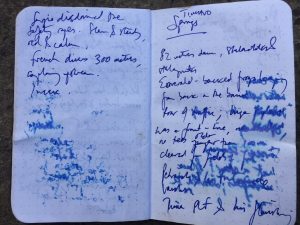
The waters of the Timavo Springs — where a river that has flowed 1,000 feet underground for dozens of miles in north-east Italy surges to the surface — made their own contribution to Macfarlane’s journal
The way you cite some of your sources and influences works particularly well in this book. You don’t impede the narrative with footnotes on the page; you just italicise a quote or a phrase and leave the notes until the end. I had a sense of the influences bubbling up from below or from the past…
I was trying to find a way to register that a phrase will fly into one’s mind at a certain time or, as you suggest, surface in the mind, and you don’t want to stop and put it in quotation marks or say, I thought, then I thought… because it’s all in the present tense. So I decided to italicise them and have them exactly as you say, surface, almost like a flash.
The other big stylistic decision is… I spent five years trying to work out how to write about deep time because past, present and future tenses only take you so far, so I decided then that I would write everything in the present where I was there, and then have these “chambers”, these other voices that were beyond human time, because I wanted to summon back the many, many pasts and futures of the underworld, from around the planet and back through even pre-human time. That was the ambition, at least. I don’t know if it works or not.
I think it works well.
But books have their subtext; Underland has its underland. In a way, readers will make two journeys in this book if they’re willing to. One is through the landscape as I’ve laid it out; the other is this work of connection and subterranean meaning-making that we do all the time but is sort-of even more relevant in this book. One subject of this book is how we try to understand the things that we can’t quite see or can’t quite bear to look at.

A sculpture in the Paris catacombs known as Le Passe-Muraille (The Passer-through-Walls) after a short story of the same name by Marcel Aymé, about a man who discovers he can pass through solid surfaces — only for his powers to desert him while he is stepping out of a wall. Picture: © LAURA BROWN
We’ve touched on this already, talking about nature and what it means in the Anthropocene, but you write in the book: “Nature is no longer only a remote peak shining in the sun or a raptor hunting over birch woods — it is also tidelines thickened with drift plastic…” Did it pain you to write that?
Yes. I don’t think I’ve ever endorsed the blithe version of nature. I don’t like it when people call it this, but the full kind-of romantic dream of a nature outside ourselves. The Wild Places, which I wrote in 2007, is full of seabird colonies dying, of drift plastic. So it’s not as if I began writing about nature as a pure dream and have finally seen that it’s not. There’s always been a mix. But this book, I think, looks hardest at what is darkest in our relationship with nature, and what we have done to it.
Which is not to say that I want to suggest that all nature is this compromised, broken thing. It’s just that we are world-makers now; we have shaped these systems. Our parts per million of carbon dioxide have aligned geological and human timescales for the first time in the history of our species and inevitably the consequences are, by definition, planetary in scale and force, and that’s a frightening, uncanny time to be living through.
I was reminded of passages by Barry Lopez — whose writing I know has been an inspiration to you — in his new book, Horizon. In one he says “the throttled Earth… is now our home. We know the wounds. We have come to accept them.” In a later passage he writes that we live in “a mutilated world” [a phrase he attributes to the poet Adam Zagajewski] and he wants to be “an emissary for all of its life.” Do you agree? Do you want to be an emissary for all of its life?
I’ll answer that an odd way round. Three big books have been published recently, and I don’t mean to place mine in any kind of status relationship with these two, but Richard Powers has published The Overstory, [winner of the 2019 Pulitzer Prize in Fiction], Barry has published Horizon, and I’m about to publish Underland. They form a trio: we have the above-ground, we have the horizon line, and then we have the underground. And all three books are 500-plus-page works that are looking hard at the broken human relationship with nature. None of them abandons hopefulness but they are all, as it were, animated by a sense of mutilation but also of a kind of loving fear, I guess. By which I mean to say that to be a celebrant of what is miraculous is a form of political work as well as to record the means and the matter of damage.
So much writing now has been overtaken by the time that the idea of a kind of a simple dream has gone. That’s what it feels like to me.
Of restoration, rewilding?
No, no. Large-scale regeneration projects are exciting to me — big ecology-appropriate tree-planting projects. I think it’s more that culture is realising that it cannot not register, cannot not react to what is happening. And it feels to me as though that has stolen up on culture in the past five to 10 years.
Young people [feel it]. I talked to a student recently and she said, “It’s odd, but I don’t really think much about the future because it doesn’t feel certain to me that there will be much of one.” That really struck to the heart.
I read an interview recently with Amy Irvine [whose Desert Cabal: A New Season in the Wilderness is a conversation with the ghost of Edward Abbey — conducted 50 years after Abbey’s Desert Solitaire: A Season in the Wilderness was published]. She suggested that lovers of the great outdoors consider taking “a vow of environmental chastity” and forgoing their weekend fling with the wild to reduce their carbon footprint: “Can we love it enough to… gulp… stay home?”
Would you go that far?
Well, I gave up eating meat a long time ago. I’ve taken a number of vows of chastity. My six-year-old hasn’t got a passport. I was writing about these things from the mid-2000s onwards. I wrote an early — well, what now looks like an early — essay on the role of culture in global warming in 2005. There was a period — I think it was 2007 to 2013 — when I didn’t fly long-haul. I’ve never been to the southern hemisphere and I repeatedly turn down invitations to fly to New Zealand, Australia.
There’s this strange profligacy that comes in where someone says — I got one yesterday, a very warm invitation — please fly to New Zealand to tell us about the Anthropocene. But I will be travelling around America to talk about these things, and I thought really hard about that. So, the answer is, I’m a sinner like the rest, but this does not go unexamined.
Can you imagine a time when you’d say to yourself, I’m not going to the Cairngorms.
No, because I get the sleeper train up to the Cairngorms. In the economies of carbon, that’s very low down the list. It may all come to that in 20, 30, 40 years’ time, but I think a sort-of utter, battened-down puritanism is not going to be successful either.
But you would turn down invitations to go to Australasia.
Yeah. I turned this one down… I just can’t do it.
What would you say to people who have read your books, who love travelling to wild places, but who nonetheless have that nagging question at the back of their minds, “Should I be going this far?”
Well, The Wild Places was written out of a sense that we were far-flinging ourselves too much; that there was this astonishment to be found within the 5,000 islands, 500 mountains and 300 rivers that we have in this island group of ours. That was a celebration of the near-at-hand. Roger Deakin called it “the undiscovered country of the nearby”, and that’s still with me very powerfully as an idea.
Now, tips of a different kind: could you tell me about books you’ve read recently on place or travel that have impressed you, or young writers whose work you think is particularly good or deserving of more attention?
Kings of the Yukon by Adam Weymouth [now in Penguin paperback]. That’s a super book and I’ve been really glad to see that find its way. [It won Weymouth The Sunday Times Young Writer of the Year Award and has been short-listed for the RSL Ondaatje Prize.]
There’s a very good book coming up by Edward Posnett, Strange Harvests: The Hidden Histories of Seven Natural Objects [due out from Viking in August], which is a sort of travel work. It begins with eider — eider down is gathered by hand, apparently in a very sustainable way, in Iceland. The ducks pluck it. That’s very interesting. I’ve just read it in proof.
Then there’s Elizabeth Jane Burnett’s The Grassling [Allen Lane] which is subtitled “A geological memoir”. She’s of British-Kenyan background and her father was a geologist; it’s a super book.
Also very good is Bathsheba Demuth’s Floating Coast: An Environmental History of the Bering Strait [due out in August from WW Norton & Co]. It’s by a serious environmental historian but also has that first-person, ethnographic aspect to it.
Which brings us back to you. You’ve been following this downwards trajectory, from the mountains to the underland, “exploring the storeys of matter that lie beneath the surface of both land and mind”. Now you’re effectively in the basement.
I am in the basement.
Where do you go from here in literary terms? What are your plans?
I’m in the crypt. Next stop, coffin. I’ve written this very strange book with Stanley Donwood called Ness, which is going to be published in November. It’s sort of Beowulf rewritten for the atomic age. It’s a 72-page prose poem mixed with a medieval mystery play, which Stanley has illustrated. It’s comparable in some ways to Holloway, which we did together [with Dan Richards].
Then I think I’ll go back up to the skies for a new book with Jackie Morris. We’re going to work on a book called The Book of Birds, which will be subtitled A Field Guide to Wonder and Loss. We want to remake the bird guide, the field guide. I think that will take us three years — if we’re quick about it.
British birds only?
No — because birds don’t recognise borders. I’ll tell you more about that next time we meet because we might be a bit further along.
* The Lost Words will become a BBC Proms family concert this summer; tickets go on sale on May 10.
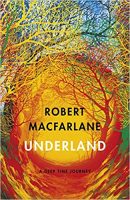 Underland is published by Hamish Hamilton (£20).
Underland is published by Hamish Hamilton (£20).
